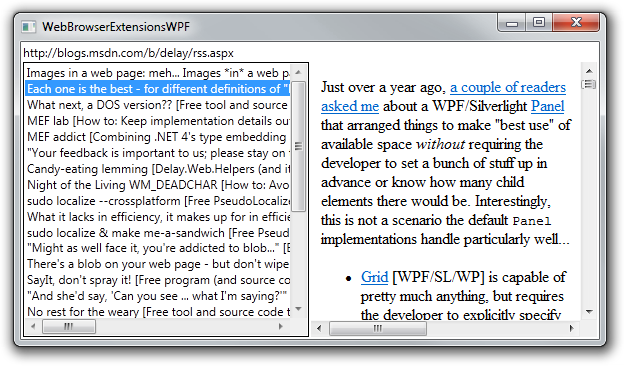Use it or lose it! [New Delay.FxCop code analysis rule helps identify unused resources in a .NET assembly]
My previous post outlined the benefits of automated code analysis and introduced the Delay.FxCop custom code analysis assembly. The initial release of Delay.FxCop included only one rule, DF1000: Check spelling of all string literals, which didn't seem like enough to me, so today's update doubles the number of rules! DF1001: Resources should be referenced - but before getting into that I'm going to spend a moment more on spell-checking...
What I planned to write for the second code analysis rule was something to check the spelling of .NET string resources (i.e., strings from a RESX file). This seemed like another place misspellings might occur and I'd heard of other custom rules that performed this same task (for example, here's a sample by Jason Kresowaty). However, in the process of doing research, I discovered rule CA1703: Resource strings should be spelled correctly which is part of the default set of rules!
To make sure it did what I expected, I started a new application, added a misspelled string resource, and ran code analysis. To my surprise, the misspelling was not detected... However, I noticed a different warning that seemed related: CA1824: Mark assemblies with NeutralResourcesLanguageAttribute "Because assembly 'Application.exe' contains a ResX-based resource file, mark it with the NeutralResourcesLanguage attribute, specifying the language of the resources within the assembly." Sure enough, when I un-commented the (project template-provided) NeutralResourcesLanguage line in AssemblyInfo.cs, the desired warning showed up:
CA1703 : Microsoft.Naming : In resource 'WpfApplication.Properties.Resources.resx', referenced by name 'SampleResource', correct the spelling of 'mispelling' in string value 'This string has a mispelling.'.
In my experience, a some people suppress CA1824 instead of addressing it. But as we've just discovered, they're also giving up on free spell checking for their assembly's string resources. That seems silly, so I recommend setting NeutralResourcesLanguageAttribute for its helpful side-effects!
Note: For expository purposes, I've included an example in the download: CA1703 : Microsoft.Naming : In resource 'WpfApplication.Properties.Resources.resx', referenced by name 'IncorrectSpelling', correct the spelling of 'mispelling' in string value 'This string has a single mispelling.'.
Once I realized resource spell checking was unnecessary, I decided to focus on a different pet peeve of mine: unused resources in an assembly. In much the same way stale chunks of unused code can be found in most applications, it's pretty common to find resources that aren't referenced and are just taking up valuable space. But while there's a built-in rule to detect certain kinds of uncalled code (CA1811: Avoid uncalled private code), I'm not aware of anything similar for resources... And though it's possible to perform this check manually (by searching for the use of each individual resource), this is the kind of boring, monotonous task that computers are made for!
Therefore, I've created the second Delay.FxCop rule, DF1001: Resources should be referenced, which compares the set of resource references in an assembly with the set of resources that are actually present. Any cases where a resource exists (whether it's a string, stream, or object), but is not referenced in code will result in an instance of the DF1001 warning during code analysis.
Aside: For directions about how to run the Delay.FxCop rules on a standalone assembly or integrate them into a project, please refer to the steps in my original post.
As a word of caution, there can be cases where DF1001 reports that a resource isn't referenced from code, but that resource is actually used by an assembly. While I don't think it will miss typical uses from code (either via the automatically-generated Resources class or one of the lower-level ResourceManager methods), the catch is that not all resource references show up in code! For example, the markup for a Silverlight or WPF application is included as a XAML/BAML resource which is loaded at run-time without an explicit reference from the assembly itself. DF1001 will (correctly; sort of) report this resource as unused, so please remember that global code analysis suppressions can be used to squelch false-positives:
[assembly: SuppressMessage("Usage", "DF1001:ResourcesShouldBeReferenced", MessageId = "mainwindow.baml", Scope = "resource", Target = "WpfApplication.g.resources", Justification = "Loaded by WPF for MainWindow.xaml.")]
Aside: There are other ways to "fool"DF1001, such as by loading a resource from a different assembly or passing a variable toResourceManager.GetString. But in terms of how things are done 95% of the time, the rule's current implementation should be accurate. Of course, if you find cases where it misreports unused resources, please let me know and I'll look into whether it's possible to improve things in a future release!
Stale references are an unnecessary annoyance: they bloat an assembly, waste time and money (for example, when localized unnecessarily), confuse new developers, and generally just get in the way. Fortunately, detecting them in an automated fashion is easy with DF1001: Resources should be referenced! After making sure unused resources really are unused, remove them from your project - and enjoy the benefits of a smaller, leaner application!











